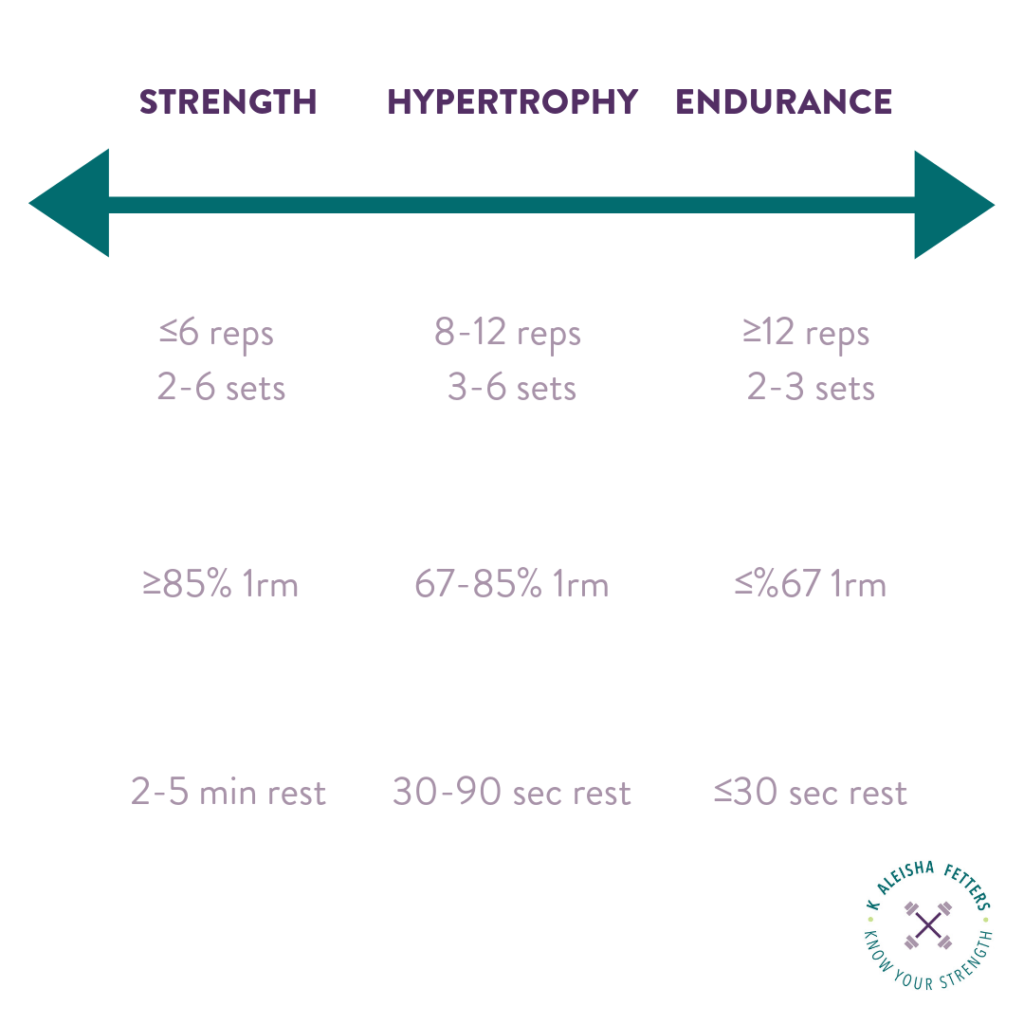
After all, strength results hinge on your ability to progressively overload your muscles, meaning you need to gradually increase the physical stress you put on a muscle to keep challenging it so that it can always be adapting and getting stronger.
In strength training, there are myriad ways to make that happen. “You can achieve progressive overload by adding sets and reps, taking less rest, using better form, or performing more challenging exercise variations,” says Caroline Juster, C.P.T., online coach and elite trainer at Fitness Formula Clubs Union Station in Chicago. “The most effective way to achieve progressive overload, however, is just to lift heavier weights.”
It just so happens that lifting more weight is also the easiest way to see and track your own progress over the weeks and months, and arguably the greatest way to get that “Damn, I’m strong!” confidence boost that comes with strength training.
Progressive overload is built into any professional training plan, but if you aren’t following one or working with a trainer closely who’s telling you “here’s how much more you need to lift today,” and figuring out exactly which weights to lift (along with when and exactly how to up the poundage over time), it can be difficult to know exactly how to lift more weight. Knowing what to expect and how to lift more weight safely, though, is extremely important for reaching your goals and staying injury-free.
How to Lift More Weight
Here, we lay out everything you need to know about choosing a starting weight, how to know when you’re ready for a heavier load, and exactly how to lift more weight.
Find the Right Starting Weight for You
“Let the reps dictate the load,” certified personal trainer Hayden Steele, C.S.C.S., an Oklahoma City–based strength coach and creator of the SHOCK training app. Translation: Decide how many reps you want to perform per set, and then home in on the amount of weight that challenges you but lets you perform all of your reps with picture-perfect form.
Your goals dictate the range of reps you should perform, and for how many sets you should do them: To develop maximal strength, lifting incredibly heavy for 2 to 6 sets of 6 or fewer reps is ideal, while lifting heavy-to-moderate weights for 3 to 6 sets of 8 to 12 reps is the way to go when it comes to building muscle size. Last, to improve muscular endurance, or how long a muscle can work before tuckering out, most experts recommend training with 2 to 3 sets of 12 or more reps.

Most training programs involve performing the bulk of exercises in that 8- to 12-rep sweet spot for a few reasons. First, it’s important to build a solid foundation in this range before working max strength with incredibly heavy loads. In this range, you’ll lift moderate loads—weights that are probably heavier than you’ve tried lifting before, but not so heavy that anything is going to give out two seconds into your set.
Second, training in this range is time-efficient and allows you to get a lot of work done without each workout taking forever.
Third, this rep range is middle-of-the-road enough that even if it’s mostly for muscle growth, it still does a bit of everything, improving strength and endurance as well. Last but not least, most exercises are generally safe to perform in this range, whereas experts generally recommend avoiding low-rep high-weight lifts for single-joint exercises such as biceps curls and triceps extensions because such heavy weights could overstress the joint, says Erica Suter, C.S.C.S., a Baltimore-based strength coach.
RELATED: Strength Training 101: Reps and Sets
At first, choose weights that you are positive you can lift, but might not be sure how many reps you can perform. If you tucker out after fewer than 8 reps or have a ton of energy left after 12 reps, rest for a couple of minutes and repeat with a different weight (lighter or heavier, depending on how your last set went). Repeat this until the weight feels right—it should be challenging, but doable.
You’ve successfully tested and found your starting weight! The next time you perform the exercise—maybe in a few days or a week—use that same weight again, but for all sets. This will allow you to “build a base,” perfect your form, and gain confidence for weight increases to come.
Are You Ready to Lift More Weight?
Newbies, get pumped: When you first start strength training, you’ll likely notice a more dramatic increase in strength than you will at any other point in your strength-training journey, Juster says. That’s largely because during the first couple of weeks of any strength program, the bulk of your strength gains don’t come from putting on actual muscle. Rather, early strength gains are due to a combination of neurological changes—basically, your brain and muscles learning to work efficiently together so that the muscle cells fire and contract—and changes within the protein of the muscle, which are stimulated by resistance training.
What’s more, each person has a different upper limit to how much strength their bodies can gain. The further you are from that upper limit, or the more inexperienced you are, the more apt your body will be to grow, grow, grow, according to the Essentials of Strength Training & Conditioning.“As you get stronger and more experienced, it’s normal for progress to slow down,” Juster says. At this point, most of your muscular wiring is already laid down.
So no matter what your training experience is, knowing when you’re ready to increase weight is as simple as counting reps and watching form. “A good rule for when someone should up the weights they use is to see if they can perform all the reps and sets with proper form,” Suter says. “If they had two to three more reps left in them, then it is time to go up in weight.”
Similarly, if you are performing all of your sets with rep ranges—for instance, that 8 to 12 range or even a 3 to 5 range—hitting the top of your rep range can be a sign it’s time to up your weights.
RELATED: 5 Reasons Your Workout Isn’t Working
If you feel like you are ready to make weight increases with deadlifts and squats before you’re ready to do so with triceps extensions or biceps curls, don’t worry. That’s natural. Many people (especially women) tend to be stronger on lower-body exercises, at least initially, says Juster. She also notes that you will likely see faster weight increases with compound, multi-joint exercises such as squats, bench presses, rows, and deadlifts than with single-joint isolation ones such as leg extensions, triceps extensions, rear-delt flyes, and hamstring curls.
Lift More Weight the Safe Way
“I want all my clients to increase their weights, no matter their goal,” says Juster, explaining that it’s a surefire way to improve both physical and mental strength. However, your goals ultimately dictate how heavy you need to go and exactly how you do it.
It’s best to look at weight increases in terms of a percentage of the weight you’ve been lifting, Suter says. For example, going from 5 to 10 pounds with shoulder raises might be the same jump in poundage as going from 100 to 105 pounds with deadlifts, but one requires doubling the weight while the other accounts for a 5 percent increase in weight. Generally, you should limit week-to-week weight increases for any given lift to no more than 10 percent.
Sometimes the weights available to you might mean you have to make a larger increase if you want to increase at all. In that case, always listen to your body, pay attention to your form, and cut your reps accordingly so that you can get through them all without breaking form.
In fact, it’s totally normal if you start using a heavier weight and then can’t quite hit the top of your rep scheme at first. In a few weeks, you will be able to and then you can up your weights again. For example, if you were doing 3 sets of 12 reps of overhead presses, you may only be able to handle 3 sets of 10 reps when you bump up the weight. If you’re still in that 8- to 12-rep range, that’s totally fine, and in time you’ll be back to feeling like 12 reps is easy and ready to once again increase the intensity.
Also, know that there are other ways to progress your workout if you’re not yet ready for more weight. “Don’t kill yourself to add weight every week,” Juster says. “If you’re stuck on an upper-body or isolation exercise, instead of bumping up the weights, focus on adding sets and reps, using better form, or achieving a better mind-muscle connection [really paying attention to which muscles should be working and consciously squeezing them].” Doing so can help get you over the hump to lifting heavier weights.
Are You Lifting Too Heavy?
Lifting more weight can be awesome, but it comes with some unwelcome side effects. The big one is delayed-onset muscle soreness, or DOMS. Each time you increase the amount of stress you put on a muscle, more microscopic damage occurs within the muscle cells, leading to an uptick in pain during the 24 to 72 hours following your workout as the muscle repairs itself, Suter says. However, just becomes DOMS hurts doesn’t mean it’s necessarily bad. It’s a normal part of your body rising to the occasion. But it’s important to differentiate between DOMS and potential overuse injuries. If a muscle hurts for more than three days after a workout or if pain comes on suddenly during training, rather than gradually afterward, you may need to ease up on the weights.
Also, beware of the dangers of “ego-lifting.” It can be tempting to get so caught up in moving more weight that you start to get loosey-goosey on form. “Never sacrifice technique to lift more weight,” says Juster, explaining that doing so is what puts you at risk for injury. (Wondering if your form is right? Using your phone to record yourself is a great way to double-check and spot errors that you wouldn’t be able to see otherwise.)
RELATED: What Exactly Is “Lifting Heavy,” Anyway?
One thing that will help keep your form in check—and reduce your risk of injury—as you lift heavier weights is giving yourself the right amount of rest, both between workouts and between reps. “Most people think rest and work are opposites, when they’re actually synergists,” says Steele, emphasizing the importance of increasing rest and recovery as you push the intensity. “The more you rest, the harder you can work. The harder you work, the more essential rest becomes.
Juster advises giving yourself at least 45 to 60 seconds of rest between all sets, and 90 to 120 seconds when performing challenging exercises or any sets that are shorter than 8 reps each (and hence, very heavy). And if you are so tired or sore going into a given workout that your technique or strength is off, back off the weights and consider upping your recovery efforts in terms of sleep, nutrition, stress management, and active recovery work like foam rolling, Steele says.
“Increasing weights in the gym is only beneficial to the point where it’s possible to recover from it,” he says. “On higher intensity training days, rest more. Pay attention to the common signs of overtraining: feeling drained, lack of energy, constant soreness, sudden drop in performance, and lack of motivation.”
Each time you approach the weights, it’s important to feel like you are ready to give your all. Sure, you’ll always have great workouts and “meh” workouts, but the goal is that in the grand scheme of things your training, energy, confidence, and strength will point up, up, up. Listen to your body. And know that whenever things start feeling easy, you can up the challenge once more.